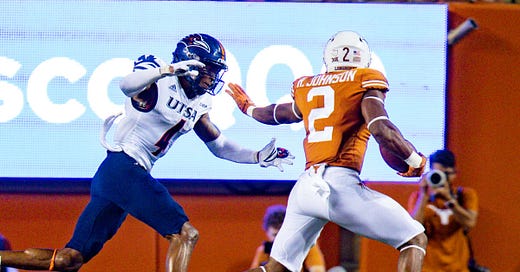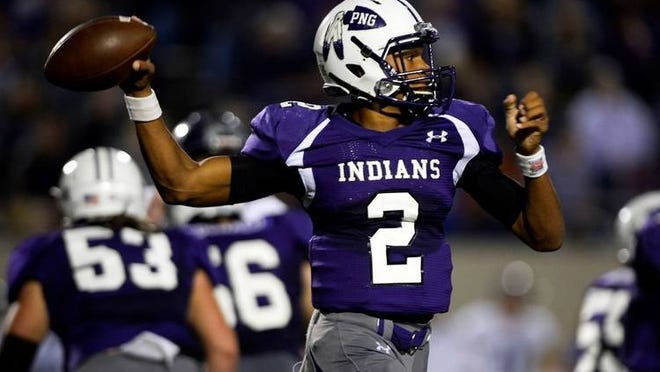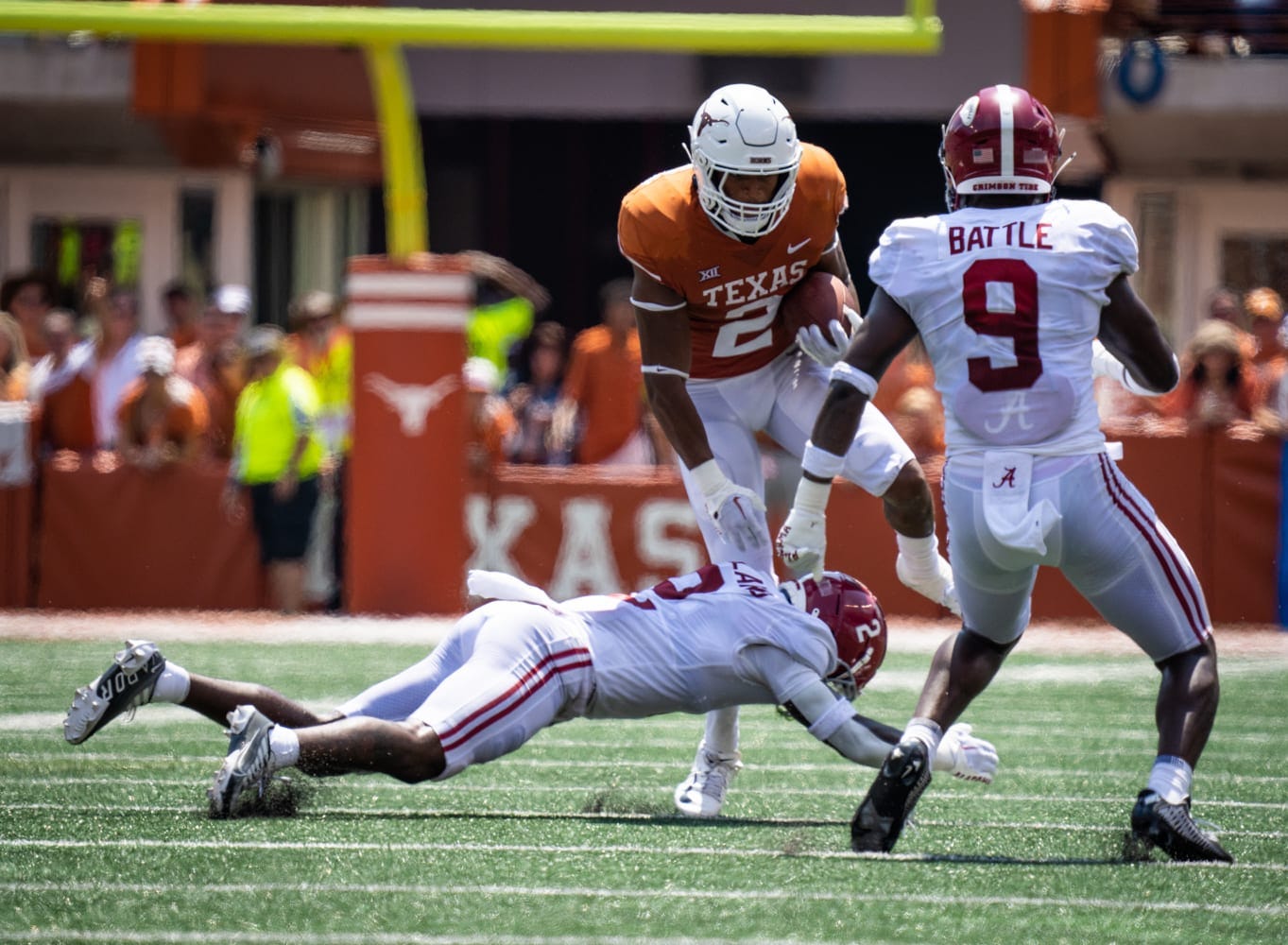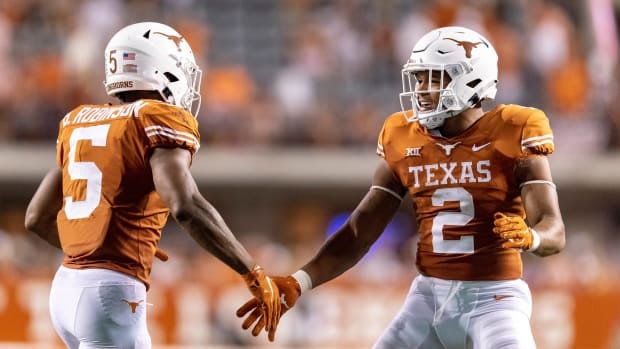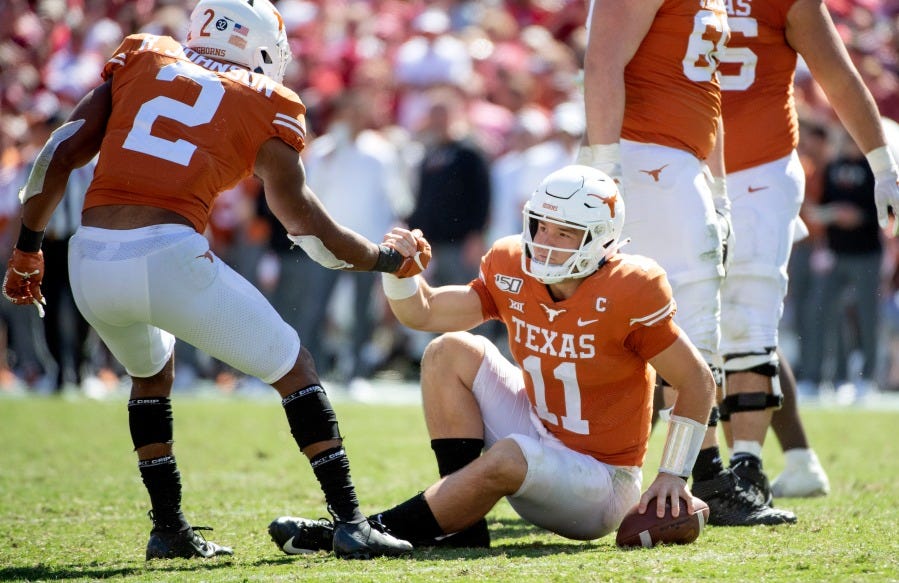There’s the famous scene in Anchorman: The Legend of Ron Burgundy where all the rival news teams show up in an abandoned alley, ready to rumble, with various weapons like tridents, swords and grenades. The anchors are ready to kill each other before Will Ferrell chimes in with a ground rule that seems to contradict the basic tenets of street fights: “no touching of the hair or face.” I’m reminded of that scene when I think about (most of) the Longhorn football that has been played in the past 12 years. Each iteration of Longhorn football has featured quirks that have littered their performances, like Burgundy’s statement. For example, the Mack Brown and Charlie Strong teams struggled to be the more physical in games you’d expected them to dominate, while Tom Herman’s teams were usually physical, yet out of control. Then in Steve Sarkisian’s first season, Texas was great at throwing the first punch, but struggled to finish its fights and deal with adversity. Coming off the heartbreaking loss to Alabama, fans were worried about a letdown and Sarkisian even warned against it. So many of the Longhorns’ losses in their time wandering the desert have featured a lowly feeling of “here we go again.” That feeling can seem as apparent with the team as it is with the fans. When Texas went down against UTSA, adversity struck again and that awful feeling seemed to return. What had been a raucous DKR crowd a week prior against Alabama became awfully quiet when Texas went down 17-7 to their UT system counterparts from down the road. The Longhorns were missing blocks and tackles, while also unaware of the ball on onside kicks and trick plays. Sark said that if the game had been a year earlier, “they might have blinked.” But flinching was clearly not an option and that was first apparent in the play of running back Roschon Johnson.
---
When you watch Johnson run, it’s as if you’re watching a version of football that is now extinct. He seeks out contact like a missile in a way that would shock many to learn that he spent most of his life as a quarterback.1 But, in Johnson’s time in Austin, he has shown a willingness to do whatever it takes to get on the field and contribute. It’s in his switch of positions that you see who Johnson is as a person and a competitor.
Hailing from Port Neches Grove High School in the Golden Triangle, Johnson was one of Tom Herman’s earliest commits and gave Texas his pledge before his junior season. Johnson was a Southeast Texas football legend, and that’s apparent in games where he scored 10 touchdowns against Crosby or demolished rival Port Arthur Memorial in the game dubbed “Mid County Madness.” He was an ideal fit for Herman’s power spread offense and you can envision an alternate history where Johnson takes the mantle from Sam Ehlinger and similarly punishes defenders from the quarterback position. Heading into his freshman year, the 2019 season, the Texas running back room was hit with a slew of injuries and in dire straits. Those ailments combined with Herman’s carless recruiting of the position caused Johnson to have to start a new position halfway into fall camp. He immediately looked natural at the position and his long run in the Red River Shootout that season propelled Texas back into the game and cemented his place as a contributor in the running back room. If you watch his touchdown against Colorado in the 2021 Alamo Bowl, you’d think he’s played running back forever.
Three years after the switch, he’s being talked about as someone who will be selected in Day 2 of the NFL Draft. He’s the type of prospect a Bill Belichick would die for, a pure football player who can do multiple things in the shift to position-less football and can also play special teams. According to his older brother Dorian Johnson, “I knew he could be a damn good running back and though it wasn’t what he wanted at all, at the same time, he knew he could help and he wanted to play.”
You can find various articles online from the 2019 season where it’s said that he was going to switch back to quarterback, but the change never occurred. In the era of the transfer portal, he’s a rarity for staying put, but his brother Dorian says despite interests from other Power Five schools, he continued with his “dream school” and “didn’t want to live far away from Texas.” He's shined for Texas and his pairing with star running back, Bijan Robinson, has been the perfect complement. It’s cliché to say one running back is thunder to the other’s lightning and that might not perfectly describe Robinson and Johnson. One is mustard and the other is …. never mind. Robinson is made of rubber and nearly impossible to get to the ground on first contact, and when that is followed up with his punishing running style, the results are painful for defenders. Three games into the season, Texas has excelled, putting both backs on the field at the same time and giving defenses a nearly impossible problem to solve. The two have the potential to be mentioned alongside the best combos in a storied history of great Texas tailback stables, ranging from the Worster Bunch, to Roosevelt Leaks and Earl Campbell, to Ricky Williams and Priest Holmes. To be mentioned alongside those legends, they need to stack up wins and that is something he is determined to give his teammates and fans. Johnson was a quarterback all his life so becoming the leader of the team was natural and despite never throwing a pass at Texas, he’s never left being a quarterback behind, even if he sits in a different meeting room nowadays.
According to Dorian, Johnson learned a lot from Sam Ehlinger’s competitiveness and his determination to lead. For years, Longhorn fans have been hearing coaches and media lament about the need for a player-led team, but the follow through on that was lacking. His brother says “Roschon hates to lose and works his ass off, so people really respect his example on and off the field. It’s hard to look a guy in the eye whose busting his ass for you and when you aren’t also giving max effort.” When Johnson arrived in Austin, he had trouble getting teammates to show up to throw with him and put in extra work. Whereas now, much of the team followed him as he led voluntary workouts all summer. Johnson deserves immense credit for never shying away from the leadership responsibilities of being a quarterback, as it has been needed on a roster with younger players starting at the quarterback position. Dorian says he has seen his brother grow into a “leader who demands respect from his players and coaches. He’s the leader of the Texas Longhorns…you can’t be any prouder, right?”
---
Three plays against UTSA highlight Johnson and his will to win that inspired a comeback. First, there was his one-handed catch on the first Longhorn scoring drive that turned a poor Hudson Card throw into a long run and catch on 1st and 20. Johnson would score himself a few plays later, putting the Longhorns on the board. That catch seemed to calm Card in the way that a great robbery of a home run at an outfield wall will settle a pitcher down.
Then, after the Longhorns trailed by 10, his hurdle of a Roadrunner defender showed off his violent determination to win. His desire to gain every possible inch of turf that he possibly could served as a spark to the Longhorns players and fans, alleviating the feelings of doubt that could have seeped in at that moment. After his hurdle, I texted a friend that I hoped all Longhorn players want to win as badly as Johnson does. I might have thrown in a few more expletives, but you get the sentiment.

In the second half, out of the Wildcat, or RoCat, or “Wild Johnson” formation, he summoned his roots from the quarterback position and handed the ball off to Bijan Robinson who housed a 78-yard touchdown, which began the process of sealing the game for Texas. Johnson’s stamp on the play was so significant that Longhorn Network commentator Lowell Galindo referred to Robinson as Bijan Johnson as he crossed the goal line. The Longhorns finished the game on a 34-3 run after they went down by 10 and the missed tackles from the defense2 and lack of push from the offensive line that were present early in the game faded away as time went on.

As the Longhorns pulled away from UTSA, I reflected on the victory over Kansas State after Thanksgiving last year. The Longhorns were facing a seven-game losing streak and a 4-8 record and it was the first game in years that I didn’t even make plans to watch. It seemed like a lost cause since they went into the game without Card or Robinson and a hobbled Casey Thompson. But, Sarkisian drew up a game plan that featured Johnson almost entirely out of the wildcat formation, and he rushed for 179 yards and a touchdown, literally dragging Kansas State defenders with him. When all of Longhorn Nation was resigned to defeat, Johnson refused to lose. After that game, Steve Sarkisian said he could win a lot of games with a bunch of Roschon Johnsons. At the time, that seemed like a tough ask - the Longhorns seemed a long way away from channeling that sort of teamwide competitive spirit, but if you watched the game against UTSA progress, you could see the team start to look more and more like their leader. One day, if the Longhorns are finally out of the desert as a program, it will be because there was a Roschon Johnson in Austin and then more players like him.
Watch him seek out contact against Alabama defenders on the first and last drives of that game, he shows a complete lack of fear for his opponent.
I can’t spend too much time thinking about the absurd targeting call that went against DeMarvion Overshown, otherwise I will snap my laptop in half. However, it’s apparent that the officials have lost the plot on this rule. Targeting was instituted to make the game safer by preventing players from leading with the crown of their helmets. It was also meant to cut down on headhunting fueled by malicious intent, but now we’re just allowing faceless hall monitors in booths watching slow motion replays to take away halves of college athletes careers whenever they decide to arbitrarily give something a longer look. Overshown presented us with a masterclass on how not to target in a bang-bang situation, but on the drive after he was ejected, Hudson Card makes his game sealing scramble and a UTSA defender launches himself headfirst at the sliding quarterback, yet there’s no flag or booth review. That exact scenario was the type of play that targeting was literally introduced to prevent against. The process is asinine and the legislation is even worse.

